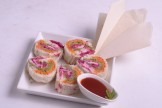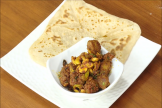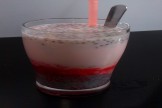
Egg burji or Anda burji is a very common and liked dish made with egg. Eggs scrambled and...

Delicious and healthy sandwich to fulfill the day's nutrition requirement....

This simple mutton fry with the rich flavor of cashew nuts is amazing in taste to serve y...
The mumbai masala chai is quite strong tea and mainly cardamom, ginger goes in making th...
Mixed veg cheesy garlic toast is a crunch of the bread mixed with the pop of plenty of ga...

Falooda, is a cold beverage popular in the Indian subcontinent. Traditionally it is made ...
Bhajaniche vade is deep-fried snack made with ‘Bhajani flour’, a flour of roasted multi-grains and pulses.
Bhajaniche vade is a deep fried snack made with bhajani flour mixed with few spices, salt and coriander leaves mixed together. Bhajani flour comprises of five kinds of flours that includes rice flour, besan flour, urad dal flour, wheat flour and jowar ki flour. To this coriander powder and Read More..
|
About Recipe
|
|||||||||||||||||||||||||||||||||||
|
|||||||||||||||||||||||||||||||||||
Bhajaniche vade is a deep fried snack made with bhajani flour mixed with few spices, salt and coriander leaves mixed together. Bhajani flour comprises of five kinds of flours that includes rice flour, besan flour, urad dal flour, wheat flour and jowar ki flour. To this coriander powder and jeera powder are added. All the ingredients are roasted, ground and mixed together and used for making this vade or thalipith.
This vade is generally preparing during the ‘Mangla gauri Vrat’ in Shravan month all over Maharashtra state. Generally we find that in most of the Indian homes or restaurants, pooris are made with wheat flour or maida flour, but this bhajaniche vade is an excellent and delicious variation to the poori or vade.
Made with the multi-grain, multi-legume flour, it definitely is a very nutritious and healthy dish that we all must try. Since all the grains and legumes are roasted before grinding, hence it is called Bhajni because bhajne means roasting in Marathi. Bhajani flour is also used for preparing the very popular Maharashtra dish called the Thalipith or pancakes that can be made in a jiffy. All you need to do is to add salt, seasonings, onions and coriander leaves and spread the pancake on the griddle.
Thalipith or vade made from bhajani flour makes a healthy breakfast as Bhajani is basically a medley of rice, jowar, besan, rice and wheat flours. This is spiced using cumin and coriander. Store this flour in airtight containers. The flour’s aroma itself is very tempting. Whenever you have a craving for this delicious and nutritious vade, just scoop up some flour, add in all the fresh goodies, herbs, and deep fry until golden in colour. Serve with delicious curries like a simple matki chi usal, vangyachi barith etc. or pickle.
There are umpteen benefits that we can procure from using whole grains, legumes, nuts and seeds in our daily diet. They are extremely abundant in proteins, healthy fats, vitamins, minerals, fibre and are a good source of energy. If consumed regularly, they can lower the risk of developing diseases like diabetes, cardiovascular disease and obesity. In contrast, frequent consumption of processed grains like refined white flour and polished white rice is a major factor of many health imbalances as they lack fibre and essential nutrients.
To gain maximum benefit from eating whole grains, legumes, nuts and seeds they need to be correctly prepared. Traditionally, whole grains, legumes, nuts and seeds are gently dry roasted which also makes them easier to digest and releases oils which add flavour to the dish. To know more about the flours used in Bhajani atta, jowar flour is gluten free whole grain flour popularly known as Sorghum. It is considered to be one of the nutritious cereals and makes a healthy diet.
Jowar ki Bhakri or roti and jowar bajre ki roti are very popular and nutritious Indian flat breads. Jowar is rich in potassium, energy, protein, calcium and Iron. Eating Jowar ki roti keeps bones and teeth healthy giving energy to the entire body and also maintains the health of heart, controls diabetes and weight loss. Wheat is another most common cereal available all over the world and today is even more in demand for its abundant health benefits. Through decades, wheat has been one of the major crops in the world.
Wheat flour is primarily used for baking breads. Foods like bread, pasta, crackers, bagels, cakes, and muffins are just a few common examples of wheat sources. Wheat is believed to be the most wholesome food items, ensuring a diet rich in nutrients. Wheat considerably lowers the hazards of heart diseases, owing to its comparatively low fat content. It also regulates blood glucose in diabetic patients. Besan flour, made from chickpeas, is a wheat-free product rich in fibre and nutrients.
Besan atta or flour adds a nutty taste to breads, sauces and other foods. If you have to avoid gluten or are watching your weight, besan flour makes a healthy and versatile alternative to high-carbohydrate wheat flour. Besan flour, also known as gram, garbanzo or chickpea flour, is made by milling chickpeas, a type of legume. It may be either finely or coarsely ground. In India, it is the staple in most north Indian cuisines. It is generally used for making dumpling, fritters (Mirchi bajji, Onion Pakoda, Aloo bonda etc) and noodles (masala sev) and used for thickening curries like kadis etc. Chickpea flour adds a nutty taste to baking, soups and sauces, and can substitute for wheat flour in most recipes. Both wheat-free and gluten-free, chickpea flour is also easier to digest than other wheat-flour substitutes, such as soy flour.
Urad dal flour is amazing flour made from dried, ground whole urad dal. The lentils are cleaned, roasted and then ground into the flour. They are parched and ground into flour after removal of the testa or the seed-coat. This flour is used in various Indian dishes. In Andhra Pradesh, the urad dal flour is used for preparing a very delicious Indian sweet namely Sunnundallu (urad dal laddu). Urad dal is also used for preparing Idli, dosa, uttappams etc.
Unlike other lentils and pulses, urad dal is a good source of protein and dietary fibre. They are low in fat and rich in B complex vitamins, calcium and potassium. Cumin or jeera is a common ingredient in Indian kitchens. Apart from adding flavor to a dish, it has got health benefits too. Roasted jeera has a very unique flavor and adds much taste to an ordinary dish like aloo ki sabzi. Apart from taste, cumin has lots of health benefits. It is considered to be good for digestion.
Coriander is another quintessential ingredient from the Indian cuisine used in many curries and gravies as it has a mild aroma instigating the appetite. Coriander powder is put in to give the dish a pleasing taste. The taste of the coriander also helps blend the tastes of all other spices that are added to the dish. Apart from being an aromatic spice, it has many curative and cooling properties and is beneficial for health, thus is found in Indian kitchens as well as in making medicines.
Coriander powder taken in combination with pinch of hing and rock salt is considered an aid to the digestive system. It is an appetite stimulant and aids in the secretion of gastric juices. To prepare this highly nutritious Bhajaniche Vade, firstly take bhajani flour in a mixing bowl, add 1 tbsp hot oil, salt, hing, turmeric powder, red chilli powder, and coriander leaves. Knead to medium dough by adding warm to hot water. Cover and let the dough rest for 15-20 minutes. Divide the dough into 10 to 12 equal sized dumplings. Take a small plastic sheet and place one dough ball on it and place another sheet over and gently press the ball with a flat base plate. Press gently as the vade needs to be slightly thick. Heat oil in a kadai for deep frying. Deep fry the vada over medium heat until it turns golden in colour.
I am sure by reading the insights of this recipe; you will surely attempt to try this dish. Do try and keep your family fit and healthy. To watch the making of this recipe, click on the below link:
Enjoy Cooking!



Emy Mahmoud Posted on Thu Aug 23 2012
we do not know black gram can I use something else
Reply 0 - Replies

mahesharuge Posted on Thu Aug 23 2012
It's called has thalipatti in northern Karnataka, you can even bake it like roti, goes well with curd or zunka vada..
Reply 0 - Replies


Maithili Desai Posted on Wed Aug 19 2015
I know it doesn't matter much to the recipe but you've made a grammatical error... 'Chi' is the wrong suffix in the way you are using the word... Call it bhajani 'cha' wada or bhajani che vade... Chi vada is wrong grammar...?
Reply 0 - Replies
jeya ravi Posted on Sat Apr 02 2016
hi cheftried tis recipe tdy came out very well v al enjoyed perfect for tis weekend thank you?
Reply 0 - Replies
vahuser Posted on Wed May 15 2013
I came across this site accidentally. Found it superb & stayed on it ever since. Sanjay with his typical cute south Indian accent is the best of all. His instructions are so easy to follow & the results amazing. Keep it up.
Reply 0 - Replies Easy recipes
Easy recipes
 Healthy Recipes
Healthy Recipes
 Dessert Recipes
Dessert Recipes
 Mutton and Lamb
Mutton and Lamb  Indian Bread Recipes
Indian Bread Recipes
 Dal Recipes
Dal Recipes
 Chutney and Pickles
Chutney and Pickles  Indo-Chinese Recipes
Indo-Chinese Recipes
 Snacks and Appetizers
Snacks and Appetizers
 Low Fat Recipes
Low Fat Recipes
 Chaat Recipes
Chaat Recipes
 Biryani and Rice
Biryani and Rice  Curry Recipes
Curry Recipes
 Indian Sweet Recipes
Indian Sweet Recipes
 Egg Recipes
Egg Recipes
 Paneer Recipes
Paneer Recipes
 Chicken Recipes
Chicken Recipes
 Indian tiffins
Indian tiffins
 Egg less Recipes
Egg less Recipes
 Soups and Salads
Soups and Salads
 Indian Sea Food
Indian Sea Food
 Manchurian Recipes
Manchurian Recipes
 Indian Drinks Recipes
Indian Drinks Recipes
 Dinner Recipes
Dinner Recipes
NiftyGuru Posted on Thu Aug 23 2012
Nice
Reply 0 - Replies